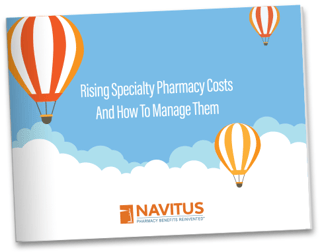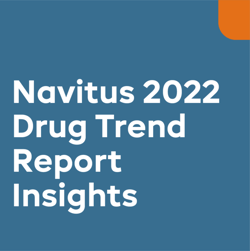Welcome to the first installment of our 3-part series on specialty drugs. Today, we’ll be tackling specialty drug costs.

This series is intended to provide an update on the specialty drug landscape and will cover topics such as cost management, clinical care and medical pharmacy solutions.
First of all, what is a specialty drug? Although no single definition exists, the Advisory Board says:
Specialty pharmacy is a loosely defined term. Generally speaking, specialty drugs are expensive, outpatient drugs that treat rare and complex conditions, such as HIV, autoimmune diseases, and organ transplant patients. They often require special handling, such as refrigeration, and patients frequently need additional support (e.g. prior authorization, financial assistance, education) to access their medications, adhere to their drug regimen, and manage side effects.1
As this definition suggests, specialty drugs don’t see wide use but can be very expensive. According to an IQVIA report, only 2.2% of prescriptions dispensed in 2018 were specialty drugs.2 Despite this, they accounted for 49.5% of dollars spent on medications.2
Specialty drug use is also increasing, growing at more than double the rate of traditional medications in 2018.2 In fact, some experts predict that specialty drugs will make up 55% of drug spend by 2021.3
Employers, health plans and government entities are increasingly concerned about these rising costs and are searching for a solution. One option that some plan sponsors may have overlooked is to replace their traditional PBM/specialty pharmacy with a full pass through alternative. As a side note, many PBMs either own their own specialty pharmacy or may have a strong influence over the specialty pharmacies within their network. Organizations serious about reducing specialty (and non-specialty) costs should look for the following characteristics in their PBM and specialty pharmacy.
- Pass-Through Model: PBMs negotiate wholesale discounts and manufacturer rebates to reduce drug costs. Under the traditional PBM model, PBMs keep a portion of these savings for themselves. This is called “spread pricing.” Spread pricing drives up costs for both the plan sponsor and their members by taking away savings that were negotiated for them.
In contrast, PBMs and specialty pharmacies with a pass-through model don’t use spread pricing. Instead, they pass through 100% of all discounts and rebates to the plan sponsor, helping keep costs down for the plan and their members.
- Transparency: Traditional specialty pricing is like a black box, with pricing details almost never disclosed to plan sponsors in full, if at all. As a result, PBM and specialty pharmacy profit per product varies tremendously and it is difficult for the plan sponsor to know why they are being charged a certain amount for any given specialty drug.
Although many PBMs and specialty pharmacies claim to be transparent, they often fail to disclose important information. Plan sponsors should do their due diligence to ensure that their PBM and specialty pharmacy are fully transparent. This means that plan sponsors should be able to see exactly where their money goes and why each specialty drug costs the amount that it does, with comprehensive auditing rights down to the claim and invoice level.
To maximize transparency and savings, plan sponsors should look for a specialty pharmacy that offers “acquisition cost plus pricing.” Under this pricing model, plan sponsors pay only the actual acquisition cost for each medication, the cost of shipping the medication, and a pre-agreed, fixed patient management fee.
- Reduced Waste: Traditional PBMs focus on maximizing rebates instead of overall savings. This means that they are incentivized to provide patients with a 90-day supply of specialty medications instead of a 30-day supply, as this can generate more rebates. However, this can lead to unnecessary waste if the medication doesn’t work for the patient or causes side effects, causing the prescriber to switch the patient to a new medication.
Pass-through PBMs focus on the lowest net cost instead of the greatest rebates. Since they don’t have an incentive to chase after higher rebates, they will provide the appropriate supply of specialty medication to minimize waste and
lower costs.
Specialty drugs, with their rising costs, new pipeline entries and increased utilization, will continue to challenge employers, health plans and other organizations for the foreseeable future. But the good news is that by selecting a pass through PBM/specialty pharmacy that’s transparent and focused on managing waste, better management and savings are possible. As an example, we were able to reduce the cost of specialty drugs by an average of 8.4% last year using a pass through model.
For more insights about specialty medications and managing specialty costs, download our new e-book, Rising Specialty Pharmacy Costs and How to Manage Them.

 Also, be sure to check back for the next installment of our specialty drug series, where we’ll share best practices for specialty clinical care.
Also, be sure to check back for the next installment of our specialty drug series, where we’ll share best practices for specialty clinical care.
- Lindsay Conway. Specialty pharmacy, explained. Advisory Board. https://www.advisory.com/research/care-transformation-center/care-transformation-center-blog/2018/03/specialty-pharmacy. Published February 22, 2018. Accessed September 4, 2019.
- Medicine Use and Spending in the US: A Review of 2018 and Outlook to 2023. IQVIA Institute for Human Data Science. https://www.iqvia.com/institute/reports/medicine-use-and-spending-in-the-us-a-review-of-2018-and-outlook-to-2023. Published May 9, 2019. Accessed August 27,2019.
- Aitken M, Kleinrock M, Pennente K, Lyle J, Nass D, Caskey L. Medicines Use and Spending in the U.S. IMS Institute for Healthcare Informatics. Published April 2016. Accessed July 23, 2019.




